
A knot is an intentional complication in cordage which may be practical or decorative, or both. Practical knots are classified by function, including hitches, bends, loop knots, and splices: a hitch fastens a rope to another object; a bend fastens two ends of a rope to each another; a loop knot is any knot creating a loop; and splice denotes any multi-strand knot, including bends and loops. A knot may also refer, in the strictest sense, to a stopper or knob at the end of a rope to keep that end from slipping through a grommet or eye. Knots have excited interest since ancient times for their practical uses, as well as their topological intricacy, studied in the area of mathematics known as knot theory.

The bowline is an ancient and simple knot used to form a fixed loop at the end of a rope. It has the virtues of being both easy to tie and untie; most notably, it is easy to untie after being subjected to a load. The bowline is sometimes referred to as King of the knots because of its importance. Along with the sheet bend and the clove hitch, the bowline is often considered one of the most essential knots.

The overhand knot, also known as a knot and half knot, is one of the most fundamental knots, and it forms the basis of many others, including the simple noose, overhand loop, angler's loop, reef knot, fisherman's knot, Half hitch, and water knot. The overhand knot is a stopper, especially when used alone, and hence it is very secure, to the point of jamming badly. It should be used if the knot is intended to be permanent. It is often used to prevent the end of a rope from unraveling. An overhand knot becomes a trefoil knot, a true knot in the mathematical sense, by joining the ends. It can also be adjusted, faired, or mis-tied as a half hitch

A miller's knot is a binding knot used to secure the opening of a sack or bag. Historically, large sacks often contained grains; thus the association of these knots with the miller's trade. Several knots are known interchangeably by these three names.
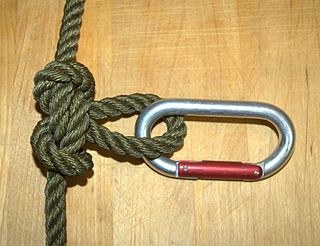
The butterfly loop, also known as lineman's loop, butterfly knot, alpine butterfly knot, Swiss loop and lineman's rider, is a knot used to form a fixed loop in the middle of a rope. Tied in the bight, it can be made in a rope without access to either of the ends; this is a distinct advantage when working with long climbing ropes. The butterfly loop is an excellent mid-line rigging knot; it handles multi-directional loading well and has a symmetrical shape that makes it easy to inspect. In a climbing context it is also useful for traverse lines, some anchors, shortening rope slings, and for isolating damaged sections of rope.

The constrictor knot is one of the most effective binding knots. Simple and secure, it is a harsh knot that can be difficult or impossible to untie once tightened. It is made similarly to a clove hitch but with one end passed under the other, forming an overhand knot under a riding turn. The double constrictor knot is an even more robust variation that features two riding turns.

A shank is a type of knot that is used to shorten a rope or take up slack, such as the sheepshank. The sheepshank knot is not stable. It will fall apart under too much load or too little load.
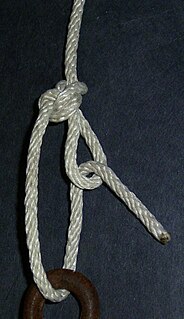
The trucker's hitch is a compound knot commonly used for securing loads on trucks or trailers. This general arrangement, using loops and turns in the rope itself to form a crude block and tackle, has long been used to tension lines and is known by multiple names. Knot author Geoffrey Budworth claims the knot can be traced back to the days when carters and hawkers used horse-drawn conveyances to move their wares from place to place.

The taut-line hitch is an adjustable loop knot for use on lines under tension. It is useful when the length of a line will need to be periodically adjusted in order to maintain tension. It is made by tying a rolling hitch around the standing part after passing around an anchor object. Tension is maintained by sliding the hitch to adjust the size of the loop, thus changing the effective length of the standing part without retying the knot.
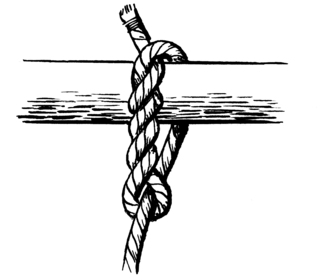
The timber hitch is a knot used to attach a single length of rope to a cylindrical object. Secure while tension is maintained, it is easily untied even after heavy loading.

A Zeppelin bend is an end-to-end joining knot formed by two symmetrically interlinked overhand knots. It is stable, secure, and highly resistant to jamming. It is also resistant to the effects of slack shaking and cyclic loading.

The Highwayman’s hitch is a quick-release draw hitch used for temporarily securing a load that will need to be released easily and cleanly. The hitch can be untied with a tug of the working end, even when under tension. The highwayman's hitch can be tied in the middle of a rope, and so the working end does not need to be passed around the anchor when tying or releasing.
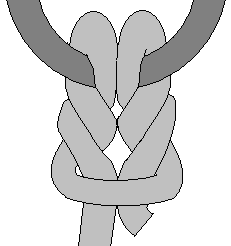
The Cat's paw is a knot used for connecting a rope to an object. It is very similar to the cow hitch except there is an additional twist on each side of the bight, making it less prone to slipping.
The cat's-paw is the common hook hitch for slings. It is the same basic form as the bale sling hitch but has additional twists. Brady says "two or three altogether," and Steel, who mentioned the name in 1794, says "three twists." It is the best of all sling hitches and is often recommended for a slippery rope. But no hitch can slip when tied in a slings since it has no ends. All that is needed is a hitch that cannot jam, and this requirement the cat's-paw fills admirably. The knot spills instantly when removed from the hook. It is the hitch always used for heavy lifts.

The sheet bend is a bend. It is practical for joining lines of different diameter or rigidity.
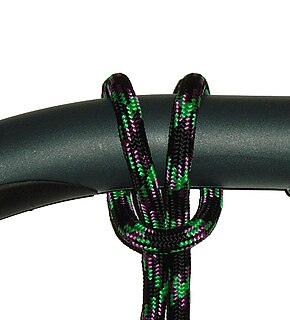
The cow hitch, also called the lark's head is a hitch knot used to attach a rope to an object. The cow hitch comprises a pair of half-hitches tied in opposing directions, as compared to the clove hitch in which the half-hitches are tied in the same direction. It has several variations and is known under a variety of names. It can be tied either with the end of the rope or with a bight.
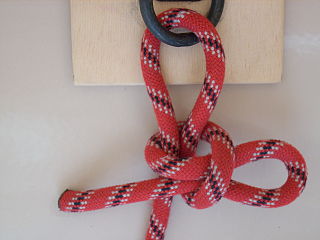
The halter hitch is a type of knot used to connect a rope to an object. As the name implies, an animal's lead rope, attached to its halter, may be tied to a post or hitching rail with this knot. The benefit of the halter hitch is that it can be easily released by pulling on one end of the rope, even if it is under tension. Some sources show the knot being finished with the free end running through the slipped loop to prevent it from working loose or being untied by a clever animal, still allowing easy but not instant untying.

The highpoint hitch is a type of knot used to attach a rope to an object. The main feature of the hitch is that it is very secure, yet if tied as a slipped knot it can be released quickly and easily with one pull, even after heavy loading. The highpoint hitch is tied in the same manner as a slipped buntline hitch until the final turn, where they diverge.

Swing hitch is a way to tie a swing rope to a branch or other horizontal beam. Ashley describes it in ABOK as "... firm, strong, secure, and easily untied once the load has been removed."


























